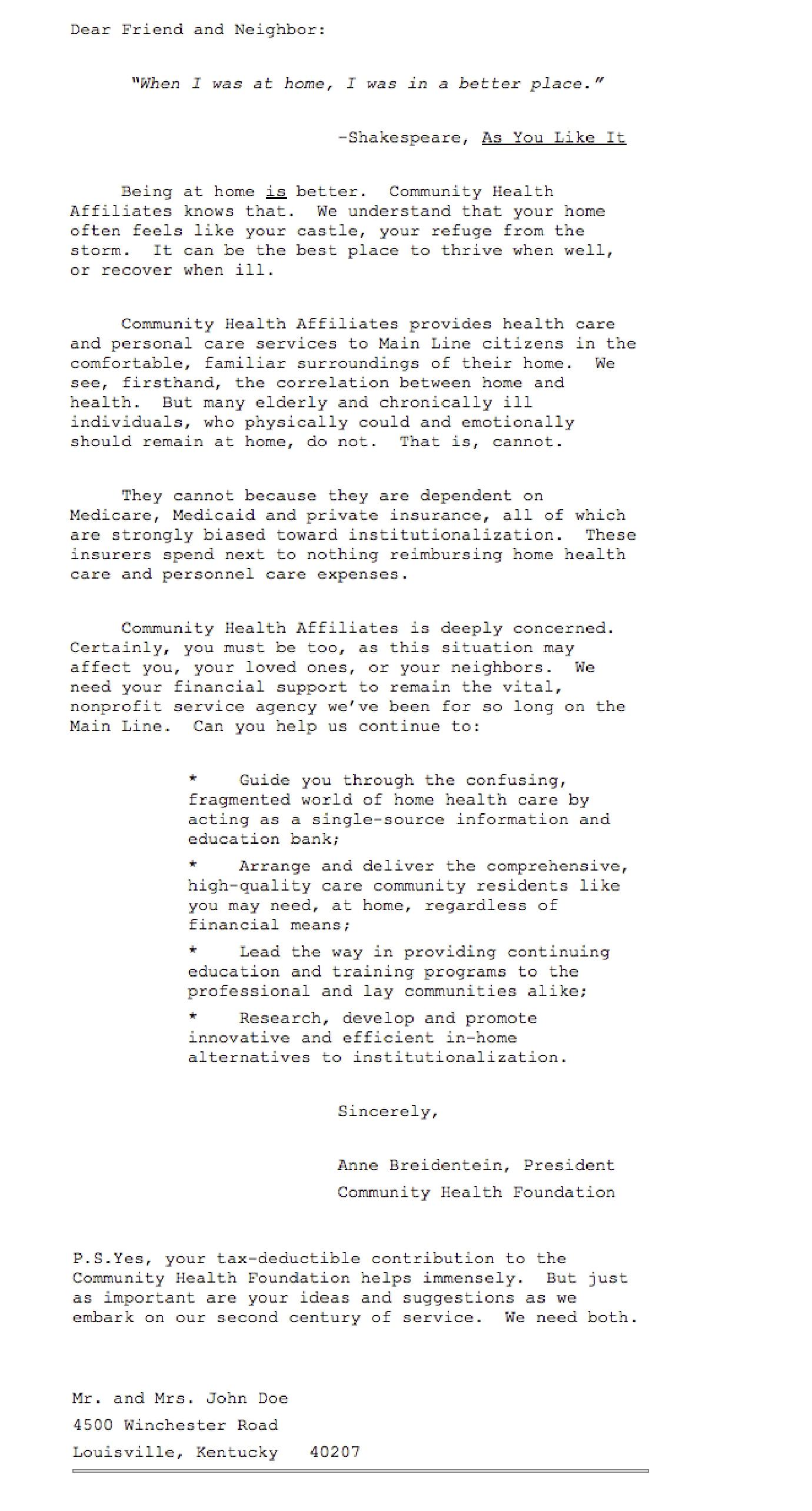Tutorial 32: Logic never makes me cry
I’m an emotional person. Maybe too emotional, I get excited, I laugh and sometimes I get angry.
- Written by
- Jerry Huntsinger
- Added
- January 28, 2019

I get teary-eyed when a father with cancer tells his four-year-old son that before long he will be gone. Then when death finally occurs, I cry without shame.
Those of you who are able to mask your emotions may not understand; and you are probably making so much money from playing poker that fundraising is just a hobby for you.
I have two letters to share with you. One comes from Claire Patterson, director of development at Community Health Affiliates in Ardmore, Pennsylvania.
You’ll see her letter printed below and I’d like you to read it. Ignore for now the fact that it is only one page and does not contain specific dollar challenges. What else is missing?
The quote from Shakespeare at the top of the letter is a nice touch and the letter does a good job of telling us about the work of Community Health Affiliates. It moves forward with good pacing and logic. However, what I wanted to see after the opening quote was the story of someone who actually received help from Community Health Affiliates.
I understand the problem with case histories, but you don’t solve that problem by sterilising the fundraising letter with logic. In a way, the letter, as it stands now, would make an excellent flyer or supporting piece in the appeal, but a successful letter needs to get right down to the level of real, living, flesh and blood people.
Believe me, it’s worth the extra effort to get permission from actual individuals to use their stories. And if required, you can disguise the name and facts enough so that no one’s privacy is threatened.
When you write about actual people, you are forced to get emotional. When you do that, you raise more money.
Next, I’d like you to read the letter by Jerry Weber, executive director of Father Maloney’s Boys’ Haven in Louisville, Kentucky. The letter is personalised, which is excellent. Ignore the fact that it is only one page and does not have a specific dollar request, and contains dual signatures. What else is missing?
I have the feeling that the individual who composed this letter – and I have absolutely no idea who drafted it – might be uncomfortable sitting in the dining hall eating lunch with the boys, or going out to the playground and playing with them, or sitting around the campfire swapping stories.
I suppose I’m not really being fair to either Jerry Weber, the executive director, or the Reverend James C Maloney, the founder and chaplain. I know for a fact that both of these men are extremely responsive to the boys and not one bit uncomfortable eating lunch with them or sharing in their fun and games. But why isn’t that conveyed in the letter?
I suppose it’s because it represents a different type of writing. An emotional approach, which can be dangerous if overdone, and awkward if the writer is not comfortable with the techniques involved.
Many letter writers may not be aware of the conclusive test results in this area. Those of us who are fortunate enough to work with clients who spend the necessary money to engage in testing know that the use of human-interest stories and case histories can increase response by such a tremendous amount that we would be derelict in our responsibility if we didn’t feature a real live story every time possible.
For those of you who want to get even more serious about this, you might want to take a course in short story writing or at least read a good textbook on that subject. Good fundraising letters and good short stories have a great deal in common.
Specifically, the use of emotion: a short story must make you either sympathetic with the central character, angry at the villain, worried about the outcome – in other words, yes, emotional.
The one major difference is that the short story finally has a resolution – it comes to an end. A fundraising letter does not have any resolution unless the donor sends a gift and makes it possible for the ending to be happy. In other words, you might say that a fundraising letter is a short story in which the donor participates in the resolution.


© SOFII Foundation 2010-2014.


















